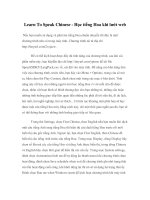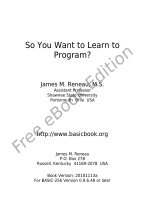Learn to speak chinese beginning mandarin chinese for native english speakers
Bạn đang xem bản rút gọn của tài liệu. Xem và tải ngay bản đầy đủ của tài liệu tại đây (5.03 MB, 120 trang )
2
Prologue: Embarking on Your Journey!
Welcome to Learn to Speak Chinese: Beginning Mandarin Chinese for Native
English Speakers! I’m so glad that you’ve started your journey to learn Mandarin—
because it will be a journey! But, I truly believe that it is important to have fun
along the way and know that this book will help you with that part of the process!
That is why you will find this book to be a brief introduction to the spoken
Mandarin language. It is by no means comprehensive, but a stepping stone for the
large gap that was found between someone wanting to learn Mandarin and
someone who was ready for some of the more academic texts. My hope is that this
book will give you a glimpse of what it’s like to learn Mandarin and help you to
focus on the most essential skills that are foundational to learning Mandarin!
In Book 1 of the series Learn to Speak Chinese we’ll take a look at tones,
PinYin, basic sentence structure, and very practical sets of vocabulary so that you
can take these fundamentals and begin to chart your own course through the
Mandarin language. For some, this will certainly not be an in-depth enough look at
Chinese language or culture. In Learn to Speak Chinese II: How to Speak Chinese
with People (An Insight into Family, Occupations, and Nationalities featuring
Chinese Characters, PinYin, and English), we take a look at family and societal
structure in China while learning greetings, family names and culture, as well as
occupations and cultural expectations for work. This second book helps to
strengthen your vocabulary while giving you a practical perspective on Chinese
culture and practical dialogue that is used in China.
Learn to Speak Chinese III: Numbers the Key to Life (An Overview of Numbers,
Time, and Money featuring Chinese Characters, PinYin, and English Dialogues)
reveals some of the core values of Chinese culture that help one gain insight into
motivations and propensities toward certain behaviors that would at first seem odd
to the foreign observer. As you gain more competence in the language itself and
insight into the culture, you will find it much easier to communicate with others in
Chinese!
3
Key to Your Success—the Fundamentals!
Well, you can definitely get started with a few basic phrases that will get the
ball rolling! But, may I suggest that after these first few phrases that you sit down
and make a plan for successfully learning the language?
Here’s what I mean: We all want to be able to see immediate results as we
begin a new endeavor. But, if we ONLY focus on the results, then we will not learn
the fundamentals that will carry us through and help us to truly learn the language
as fast as possible!
4
An Interesting Analogy
Think of it this way. Suppose there is a little one who really wants to be able to
crawl. The adult who is watching desperately wants to help, and so, reaches down
and helps the baby get on all fours, and even make the first few movements. But,
what happens when the adult lets go?
Now, what if the little one learns over and over again by repetitive motion that
certain muscles need to be exercised in order to crawl? As the baby practices
these muscles, they are then soon able to amply and quickly move across the
floor!
I know you want results—a first few basic steps. But, you will not be able to
move along on your own until you have two skills firmly in place—tones and
PinYin. As difficult as they may be to practice, and as strange as it may seem to be
practicing them, they really are the key that can allow you to soon fly across the
floor at lightning speed!
And of course, I concede that until the new learner sees what those repetitive
motions can do for them, it’s really hard to go through the exercises! We need the
vision to see where those exercises can take us! That’s why we need to learn just
a few beginning phrases and feel comfortable repeating them—it’s only natural!
5
Your Road to Success
Please don’t deny the importance of these two elements—tones and PinYin!
Once you accept them and embrace them, you really will be off to the races! Not
only that, but you will feel the wind in your hair and the invigorating thrill of
exercising your own skills to a degree you never thought possible!
Mandarin doesn’t have to be hard unless you let it! Time has shown again and
again that the principles of mastering the tones and PinYin are the road to success.
Don’t think that you can veer off the path and still make the same type of
progress. Realize that you have a limited time to learn this language, and that the
shortest distance between two points is a straight line. Stay on the path to
success!
During your journey, be exposed to, understand, practice, apply, and MASTER
the fine art of tones and the PinYin system of phonetics—you’ll be so glad you did!
6
Table of Contents
Prologue: Embarking on Your Journey!
Key to Your Success—the Fundamentals!
An Interesting Analogy
Your Road to Success
Overview of the Tones
Easy Combinations
Moderate Combinations
Challenging Combinations
Overview of PinYin
Overview of the Grammar
Overview of Grammar: Simple Questions
Overview of the Grammar: Simple Phrases
Simple Phrases: Prepositions
Simple Phrases: Question Words
Overview of the Grammar: Simple Dialogue
Overview of Important Words
Subjects
Review of Subjects
Answers for Subjects
Time Phrases
Review of Time Phrases
Answers for Time Phrases
Places
Review of Places
Answers for Places
Verbs
Review of Verbs
Answer for Verbs
Epilogue: A Pause in Your Journey
7
Overview of the Tones
What are tones? Tones are the pitches that are used when speaking a particular
sound—kind of like music added to the words that someone says. And boy, do they
make a huge difference in learning Mandarin! You can say four entirely different
things (with the SAME sound, but with different tones).
The basics of each tone are briefly explained below. Understanding how each
tone works is crucial to your mastery of the language. If you skip over this as if it is
nothing, then I can guarantee that most Chinese speakers will feel you know
NOTHING about the language itself!
On the other hand, if you master the tones, you will get compliments all day
long about how wonderful your Chinese is—even if you can only speak a few words!
•
First tone: a higher than normal flat pitch (This pitch is
extremely annoying if repeated over & over again—much like a high
monotone singer who is blatantly trying to annoy you!)
•
Second tone: a rising pitch that begins at your normal
speaking pitch and rises (This is probably the hardest to distinguish and
even native Chinese speakers sometimes confuse the second and third
tones).
•
Third tone: a falling & rising tone that begins at your normal
pitch, falls, & then rises (It’s sometimes pretty obvious when you hear
this pitch because it’s pretty distinct).
•
Fourth tone: a falling pitch that usually begins at a higher than
normal pitch and falls softly (Most English speakers make the mistake of
landing too quickly & makes it sound as if you are angry as you speak this
tone. Be careful not to be part of the vast majority: Land with style and
grace).
The true difficulty and skill comes in two parts. First, being able to both speak
and distinguish between the various tones is quite a challenge! But never fear,
with time it will become easier! Basically, you will need to train your ear over time
to be able to tell the difference between the four tones (and the one neutral tone—
which is toneless like when speaking English).
The good news is that even many native Chinese speakers sometimes have
difficulty distinguishing between the second and third tone! If their PinYin training
wasn’t solid, or they did not even receive this type of training when they were in
school, they might even have difficulty identifying the tone for you (even though
they can speak it perfectly)!
Another reason for this, however, is that the third tone when it is combined in a
particular sequence, NO LONGER IS A THIRD TONE! Yeah, talk about tricky! (But,
8
it’s a great rule to keep your throat and voice box from going crazy)! When there is
a 3-3 sequence (or two third tones together), then the first of the two tones
actually changes to rising pitch (second tone).
When you take this into
consideration, it’s very easily understood how the second and third tones could be
confused!
At any rate, the second challenge should be discussed. Second, putting the
various tones together in different combinations of sequences is the TRUE
challenge and test of your tonal skills! It’s really the connection between the tones
that threw me off, so let’s take a look at some of the common combinations (that
cause us trouble) more closely.
9
Easy Combinations
1-1
1-4
2-1
2-4
4-2
In each of these three cases, it seems obvious how to make the
transition to the next tone. In the 1-1 you’re high and so, begin the
second half where you left off.
When you’re speaking the first tone, it’s quite simple to gently fall for
the fourth tone and finish the 1-4 combination with ease.
Continue rising in pitch until you reach the first tone.
Continuing where you left off is also true for the 2-4 where you rise and
are already at a high pitch from which you can fall.
The opposite is true when using the 4-2, you gently fall and then begin
the rising tone at the lower pitch.
10
Moderate Combinations
4-1
After you gently fall, there is now a huge gap between where you
ended and where you must begin the first tone! In this case, there is a
brief silence between the fourth and first tones.
3-4 OR 3-1 For both of these combinations, upon finishing the third tone, you
will continue raising the pitch in order to meet the high point from which
to begin the first or fourth tone (whichever you happen to be practicing).
2-3
In theory, this is not a difficult combination, but when you use your
voice, it’s another story! Begin rising, fall, and rise again—in an almost
seamless manner. The problem is that before you fall, you must begin
the sound of the second character you are speaking! Good luck!
11
Challenging Combinations
3-3
Thankfully, the 3-3 converts into the 2-3 above!
3-2
THE REAL CHALLENGE! Some speakers can fall gracefully and then
continue rising until they reach the high pitch. However, since you must
usually begin speaking the second character somewhere in the process,
I’ve found it easier to actually briefly drop the pitch mid-ascent in order to
begin the second character. In this way, it’s not seamless, but at least I
can be understood!
12
Overview of PinYin
The second essential skill you’ll need next in speaking Mandarin is your mastery
of the PinYin system of phonetics. This is your code book for making sense of
the language! Chinese does not have an alphabet. Instead, characters are used
as a picture to describe an idea or thought.
That character is then given a sound (like reading a picture) and that’s why
PinYin is important. Basically, PinYin is the system that helps us make sense of the
sounds so that one day in the future, we can not only understand the spoken
language, but can also look up the written characters in the dictionary based on the
sound.
When you learn this system by practicing it every day, you’ll strengthen your
tones by using each of the sounds to practice your four tones—that’s 46 x 4, so 184
times! If you “sing” each of the tones on every single sound—that means that you
will have practiced each tone with each sound daily—making you a confident
Chinese speaker in no time!
When you “sing” all four tones with each sound, you learn the tones so much
better & soon can speak the difference AND hear the difference between each of
the tones. (Basically, you’re on your way to accomplish the MOST IMPORTANT step
—the tones—extremely well)!
Overview
PinYin: the Finals
I’m sure you’re wondering why I’m starting at the end with the finals!
13
of
For
Chinese speakers, this is absolutely absurd! But, when you take into consideration
that native English speakers often learn vowels before consonants, it’s not that
difficult
to
see
why
I
chose
to
start
here.
14
15
16
17
Overview of PinYin:
the Initials
The initials are very similar to consonants in English! You will see the names of
the initials below. The initial is the “sound” that it makes, while its name is the
combination of the initial with the final that follows it in parenthesis.
Here’s what I mean. When you say the letters, “b,” “c,” and “d” in English, you
actually say “bee,” “cee,” and “dee.” But, when you say the sound of the letter at
the beginning of the word, you only hear the consonant “b” instead of “bee.”
(Imagine trying to read “boat” as “bee+oat”)!
In the same way, be sure to only say the sound of the initial when pronouncing
a character, but use its name as you practice your daily “singing” routine. View a
brief video on the daily routine.
But, you will also notice below that there are a few apparently repeated
sounds. Notice that j (i) and zh (i) would appear to be repetitive. However,
because “j” is ONLY used with the “i” when it sounds as “ee” and the “zh” is used
with the “i” when it sounds as “ir.”
18
19
20
21
22
Overview of the Grammar
You’re going to
hate me for saying this (and it’s not entirely true for all cases), but in general if you
think of Mandarin as exactly opposite of English in word order, you’ll be right most
of the time! You’ll see what I mean in the following examples.
Of course, this is the hugely simplified version (without talking about direct
objects, prepositions, or adjectives), but you get the general idea!
Also, just like
we can flip around a sentence for emphasis or use in a particular situation, so can
Chinese speakers.
Instead of “I’ll see you at the meeting at 7pm,” we could say, “At the meeting,
a t 7pm, I’ll see you there!” The Chinese rendition would be something more like
“At 7pm, at the meeting, I’ll see you there!” So you can see that one example isn’t
enough to explain the entire language because it’s living and flexible, just like your
native tongue!
Also good to note is the fact that there are NO CONJUGATIONS in Chinese! Hiphip-hooray! No “am, is, are, was, were, be, being, been,” just plain, simple
to express being! You don’t have to worry whether it’s singular or plural,
or past, present, or future)!
23
Overview of Grammar: Simple Questions
The wild part begins when we start to take a look at how questions are asked!
Really, Chinese makes a lot more sense in this instance than does English. (Try
explaining our word order to someone who is learning English, and see the
response you get)!
If you’re concerned about past, present, or future, you only need to be
concerned with
&
with past and
[to want],
[will—as in definitely], or
[would like to]. But, those explanations can
wait for a future date!
The question word order reflects the same idea in statement form, but uses a
special article at the end of the sentence to indicate that it is a question. (I know,
some of you Chinese teachers out there are going to argue with me whether or not
is an article! But, I have to ask you, what type of equivalent word do
we have for this in English?)
24
The
EXACT
same
placement
of
words,
but
substituting
in
for the time! How
logical is that?! (And we wonder sometimes why Chinese students call it “crazy
English”)? But, hopefully you can see the simplicity in transferring between a
question and a statement, and can definitely use this to your advantage!
25









